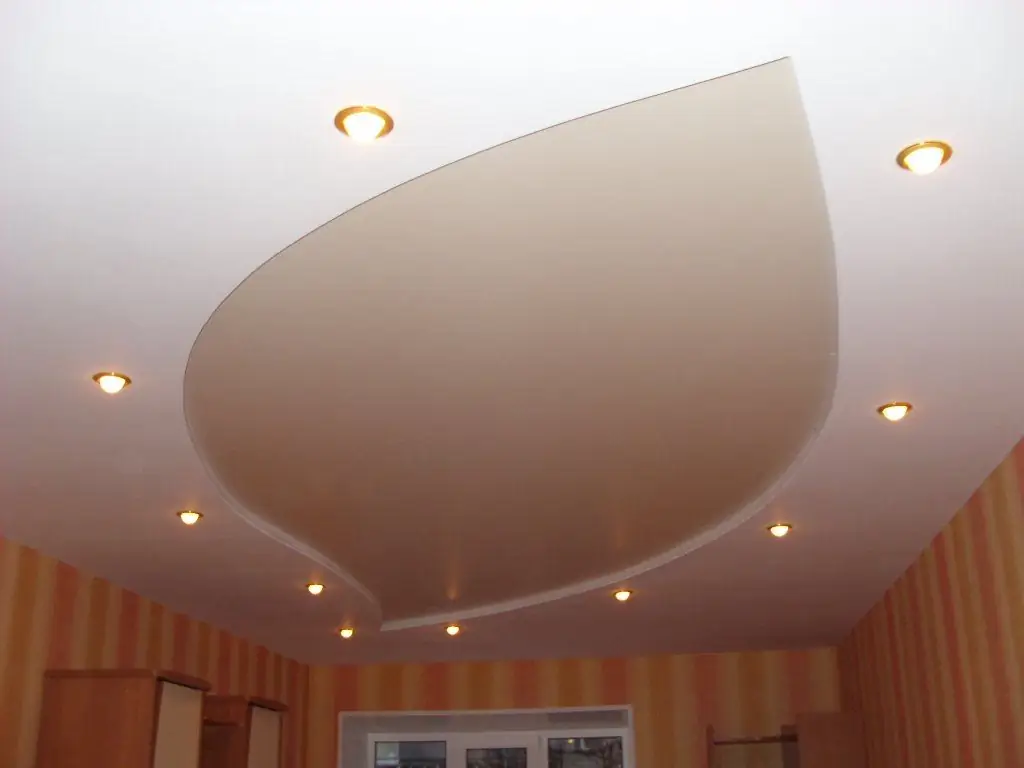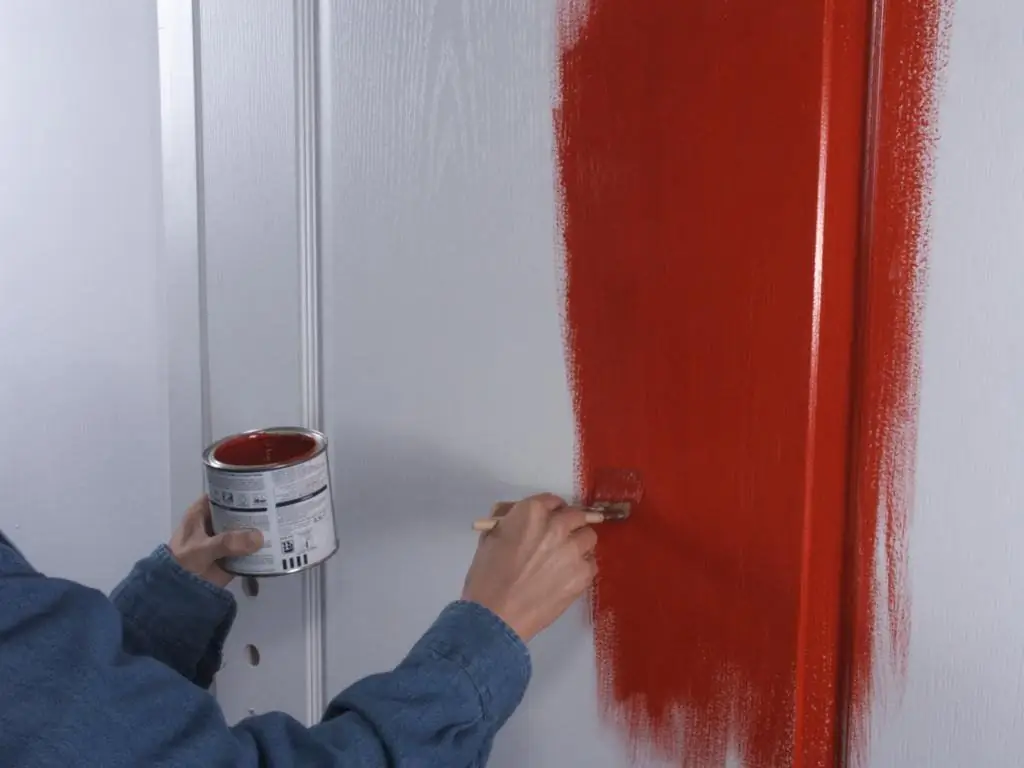
Table of contents:
- We paint the ceiling with water-based paint manually and with a spray gun
- Required tools and materials
- Preliminary preparation and processing of the ceiling
- The process of painting the ceiling with water-based paint
- Secrets and features of work: how to avoid mistakes and correct shortcomings on the go
- Author Bailey Albertson [email protected].
- Public 2023-12-17 12:53.
- Last modified 2025-06-01 07:32.
We paint the ceiling with water-based paint manually and with a spray gun

Ceiling decoration, including painting, is perhaps the most time-consuming part of the repair. Modern technologies make this process much easier. Especially popular in recent years are water-based paints - high-quality materials that are quite easy to use. But painting the ceiling with water emulsion also has its own secrets and features that must be taken into account when working.
Content
- 1 Required tools and materials
- 2 Preliminary preparation and processing of the ceiling
-
3 Process of painting the ceiling with water-based paint
-
3.1 Roller painting
3.1.1 Video on the correct painting of the ceiling with a water emulsion with a roller
-
3.2 Application of the spray gun
3.2.1 How to paint the ceiling with a spray gun - video
-
-
4 Secrets and features of work: how to avoid mistakes and correct shortcomings on the go
4.1 Errors when working with a spray gun
Required tools and materials
First of all, you need to choose the right paint. According to its composition, a water emulsion is:
- acrylic;
- silicone;
- silicate;
- latex.
But even the composition is not the most important thing that you need to pay attention to. A more important indicator is the hiding power of the paint. It is very simple to recognize it: the more square meters, which is enough for 1 liter of paint, the better.

A wide color palette is far from the only plus of water-based paints
If you intend to treat ceilings in rooms with high humidity (for example, in the kitchen or bathroom), buy a water-based paint for wet rooms. Do not forget about the presence of anti-mold components in its composition. In addition, paint for such rooms must be washable. In dry rooms, you can use a conventional water emulsion.
A careful reading of the label on the jar will help you make your choice. Certain inscriptions need explanation.
- “The paint is highly resistant to dry abrasion” - the painted surface must not be exposed to moisture. Cleaning only with a vacuum cleaner or dry cloth.
- "The paint can be used in dry rooms with reduced operational load" - for painting the ceiling in the kitchen and bathroom, where there is high humidity and a large amount of greasy fumes, such a product is not suitable.
- "Indelible paint, with high resistance to abrasion" - ceilings painted with such paint can be easily and painlessly wet cleaned without the use of special detergents.
- “The paint is highly resistant to abrasion during intensive washing and is dirt-repellent” - the best coating for the ceiling. You can easily clean the surface even with the use of detergents.
The choice between glossy and matt water-based paint depends only on your taste. But keep in mind that a matte finish will visually increase the height of the room, mask small defects, but it will be difficult to wash. Glossy paint looks more spectacular, easier to clean and does not wear out for a long time, while maintaining its quality characteristics. But she can easily identify all the minor flaws on the ceiling. It is believed that the best choice is a semi-gloss or semi-gloss paint.
Also, be sure to get a primer - it must be used when painting. If you need to repair the ceiling, then buy another solution for washing off old paint and putty.

A can of water-based paint, a brush, a roller and a bath - everything you need to work
Now let's move on to the necessary tools for work. You will need:
- putty knife;
- paint bath;
- a roller about 20 cm wide with medium pile (velor and foam rubber coats are absolutely not suitable);
- fine grit sandpaper;
- a thin brush 5-8 cm wide for painting corners and edges.
You've probably noticed the remark about the nap roller. The fact is that the foam roller will leave bubbles on the surface, and the velor does not absorb enough paint, and you will very often have to dip the tool into the bath. Consider this when buying.

Telescopic roller handle helps you to avoid the need for a stepladder
If for some reason you do not want or cannot use a stepladder when painting the ceiling, a telescopic roller handle will help you.
Preliminary preparation and processing of the ceiling
Before you start painting with water-based emulsion, the ceiling must be prepared for subsequent work.
To get a positive result of the work, do not paint the ceiling with water emulsion over the old layer. It must be removed with a spatula, using an alkaline detergent, and then rinse the ceiling with clean water and allow to dry.
To simplify the task, use this simple technique:
- Moisten the ceiling with plenty of water (you can use a spray bottle or foam roller to do this).
- After half an hour, repeat the procedure. The old coating will be properly saturated with moisture.
- The next step is to create a draft in the room. Open all windows and doors and blisters will form on the surface of the ceiling. You can easily remove such a wet layer of the old coating with a spatula.
After this pre-treatment, inaccuracies can become visible on the surface of the ceiling. They are easy enough to eliminate: open all the cracks and treat them with a finishing putty. After it dries, the surface must be wiped with sandpaper, and the dust must be wiped off with a damp cloth or removed with a vacuum cleaner.

During the preparation of the ceiling for painting, it may be necessary to eliminate minor errors
Now proceed to priming the ceiling. Use a deep penetration primer for this. Once dry, paint can be applied to the surface.
The process of painting the ceiling with water-based paint
It is good that progress does not stand still, and not only several methods can be used to perform the same work, but also various auxiliary devices. For example, you can paint the ceiling with water-based emulsion manually or using a spray gun.
Roller painting
-
Carefully remove the lid from the jar and stir the contents thoroughly. In some cases, water-based paint must be diluted to the desired thickness with water (information about this, as a rule, is contained in the instructions). Usually, this requires no more than 10% water from the total paint volume.

Thinning paint with water Open the can, stir the paint and dilute with water if necessary
-
First, brush the corners and edges of the ceiling along the walls. This will help you not to stain the walls during subsequent work.

Painting corners with a brush First, paint over the corners and edges with a brush.
-
Pour a small amount of paint into a paint bath. Dip a roller in it and roll it over the corrugated surface so that the paint is evenly distributed and its excess is removed.

Paint roller in paint Draw paint on a roller and wipe off excess on the tray
- Start painting from the window across the direction of the sun's rays, gradually moving deeper into the room.
-
When the first coat of paint is dry, apply the second. This should also be done from the window, but along the direction of the sun's rays. So you will eliminate all unpainted areas that have escaped your sight, but would certainly appear over time.

Scheme of applying water-based paint on the ceiling This diagram will show you how to properly apply paint layers to the ceiling.
-
Small bumps and bubbles found after drying the surface, carefully remove with fine-grained sandpaper.

Woman painting the ceiling Small flaws that have arisen in the process can be wiped with sandpaper and, if necessary, painted over with a brush
The whole process, taking into account the drying of the layers, can take you several days. It is recommended to carry out painting work in the morning and early in the evening: during this period, the sun's rays fall on the surface optimally, this will help you to correctly assess how evenly the paint has laid.
Video on the correct painting of the ceiling with a water emulsion using a roller
Application of a spray gun
You will enjoy this job: it is quick and easy compared to using a roller. The most important thing in the process is to achieve a thin, as uniform layer as possible.
1. Before you start painting the ceiling, move the nozzle of the device away from the surface to be painted, as in the first seconds the spray gun throws out a lot of paint.

Before starting work, "bleed" a small amount of paint from the device
2. When the spray is uniform, paint the ceiling. The distance between the spray gun and the ceiling surface should be between 30 and 50 cm. Move the nozzle at a speed of about 5 seconds per 1 running meter. In this case, direct the jet strictly perpendicular to the surface of the ceiling to be painted.

Hold spray gun at required distance from surface
3. To simplify the process, divide the surface mentally into squares. Paint them in turn, first with movements across, then along. In this case, do not linger for a long time in one area, otherwise the layer will turn out to be thick, and the paint will flow down. Maintain an even pace while coloring.

You need to work with a spray gun according to the already known scheme: one layer is across the direction of the light, the second is along
It is recommended to apply paint with a spray gun in 3 layers, each next one is put after the previous one is completely dry. On an uncured surface, the paint will not set and will quickly begin to flake.
How to paint the ceiling with a spray gun - video
Secrets and features of work: how to avoid mistakes and correct shortcomings on the go
If during the staining process you violated the technology and applied the water-based paint unevenly, places with different shades may form (light from them is reflected in varying degrees of intensity), to avoid this, observe the direction of staining.
Do not try to correct such irregularities until the surface is dry - this will exacerbate the problem. Wait until it is completely dry and apply another layer to hide imperfections. If this does not help, remove the layer with sandpaper and apply again.
When painting a drywall ceiling, do not use paint that is too thinly diluted with water. It can soak the paper layer of the finishing material so much that the surface is covered with bubbles and begins to exfoliate. And since the ceiling is not a wall for you, heartless gravity will do its job up to the fact that the surface will have to be overhauled. We are not pursuing such goals, right?
It is better to paint the plastered ceiling with a water emulsion using a spray gun. This device will distribute the paint over the ceiling much more evenly than a roller. But don't forget to apply a primer first.
If the ceiling was previously whitewashed, it is better to wash off the old layer. The water-based paint applied to the limestone or whitewash will not only lie unevenly, but also begin to exfoliate. The same applies to old paint: if light damage appears on it, remove the layer.

Small mistakes and inaccuracies in painting the ceiling can be easily corrected with a roller and a brush.
To prevent streaks on the ceiling during painting, first apply a layer of diluted water-based paint with a wide roller. After drying, you can easily consider all the flaws. When you do the main painting, pay special attention to these areas and treat them carefully.
Be sure to observe the direction of the layers: the penultimate layer should be perpendicular to the window, and the last one should be parallel. Take your time - wait until the layers are completely dry.
Excess paint can be removed in the following way: roll over the surface with a roller, on which there is no paint left, and its pile will absorb all excess.
Errors when working with a spray gun
If you do not move the spray gun nozzle quickly enough during work, the water emulsion on the ceiling will collect in small drops. Collect the excess with a sponge and, after drying, apply another coat of paint.
Too thick will cause the paint to peel off. Places where delamination has appeared, putty, rub with emery and prime, and paint again after drying. It is advisable to apply another coat of paint.

With some drawbacks in painting with a spray gun, you may need an additional putty and primer
Have small bumps and grains appeared on the ceiling after painting? Surely the paint used was initially dirty. To get rid of such a marriage, go over the entire surface of the ceiling with emery and paint it again, only strain the paint through gauze first.
As you can see, it is enough to follow the recommendations and simple rules so that painting the ceiling with water-based paint does not become too problematic and time-consuming for you. Both the roller and the spray gun are excellent helpers in this matter, and our advice will surely make your task easier. Share with us in the comments your experience of painting the ceiling with water-based paint or ask questions on the topic. Good luck and comfort to your home!
Recommended:
How And What To Paint A Drywall Ceiling With Your Own Hands + Video

Features of painting a plasterboard ceiling with your own hands. Choosing the right paint. step by step process
How To Drain Water From A Stretch Ceiling On Your Own, Including After Flooding, How Much Water It Can Withstand, How To Dry It, What To Do If It Sags

Is it possible to drain the water from the stretch ceiling on your own: what is needed for this and how to do it. How much water will the ceiling withstand and how to dry it after draining
Painting Wooden Doors: Which Paint Is Better To Choose, As Well As How To Properly Varnish The Surface

How to prepare a door for painting and which product to choose. Tools and materials for painting wooden doors. How to paint yourself
What Paint Is Best For The Ceiling In The Kitchen: Types, Methods Of Painting, Recommendations, Photos

What to consider when painting the ceiling in the kitchen. Choice of paint and color. Tools, preparation and work stages. Kitchen design with a painted ceiling
Independent Redecoration Of The Ceiling: Whitewashing, Painting, Plastering, Plasterboard Repair + Video

Practical advice and recommendations for DIY ceiling repair. Required materials and tools, step-by-step process description
